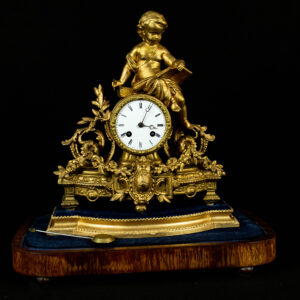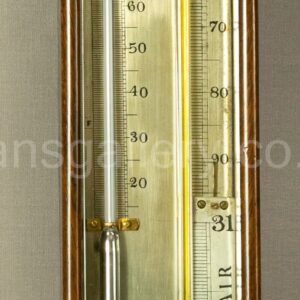Barometer Antique Admiral Fitzroy Victorian Mahogany
£795
A rare, late Victorian Mahogany and Oak – cased “The Fitzroy Aneroid” barometer, also with a thermometer.
AN UNUSUALLY LARGE VICTORIAN ADMIRAL FITZROY BAROMETER with atmospher-ic gauge, Fattorini & Sons enamelled thermometer and original paper-lined backboard.
Description
A rare, late Victorian Mahogany and Oak – cased “The Fitzroy Aneroid” barometer, also with a thermometer.
AN UNUSUALLY LARGE VICTORIAN ADMIRAL FITZROY BAROMETER with atmospheric gauge, Fattorini & Sons enamelled thermometer and original paper-lined backboard. 115 cm x 25 x 8 cm. Mercury has been emptied, so it is transportable. Some wear and tear to the paper description on the board in spite of its age. Beautiful and well-polished finish to the wood and the back can be opened by screws to reveal the glass tube for refilling mercury if required. The barometer will be shipped without any mercury due to transportation restrictions.
Note: Vice-Admiral Robert FitzRoy FRS (5 July 1805 – 30 April 1865) was an English officer of the Royal Navy and a scientist. He achieved lasting fame as the captain of HMS Beagle during Charles Darwin’s famous voyage, FitzRoy’s second expedition to Tierra del Fuego and the Southern Cone. FitzRoy was a pioneering meteorologist who made ac-curate daily weather predictions, which he called by a new name of his own invention: “forecasts”. In 1854 he established what would later be called the Met Office, and created systems to get weather information to sailors and fishermen for their safety. He was an able surveyor and hydrographer. As Governor of New Zealand, serving from 1843 to 1845, he tried to protect the Mori from illegal land sales claimed by British settlers
Barometers are used to measure atmospheric pressure changes as an indicator of changes in the weather. Today, weather stations around the world use stick barometers for accurate forecasting, and for those of us who love nostalgia, an antique barometer provides the same information in a masterfully crafted case.
Evangelista Torricelli is credited with inventing the first barometer in 1643.
A physician and mathematician, Torricelli had moved to Florence to assist Galileo. While performing various experiments concerning the nature of air and vacuums, he uncovered the basic principle of the barometer design. Furthermore, he used mercury in his vacuum experiments and discovered that the height of the mercury, which changed from day to day, was related to changes in atmospheric pressure. Soon, his principles were accepted by scientists throughout the continent.
We strive to describe each item as accurately as possible, and photographs form an essential part of the item description. Please review them carefully prior to purchase. Please note that no mercury or liquids will be included in the item as it is prohibited for transport. Leans Gallery does not guarantee the working of Clocks, Music Boxes and Barometers. Any qualified local horologist can refill or service the instrument with ease.
International buyers: Please be aware that some countries may charge a small percentage for customs duties, import taxes, or local fees. You are responsible for any fees applied by your country. All items are carefully packed to ensure safe delivery within the UK and internationally.
Return Policy: No returns unless the item is not as described. Should a return be necessary, all return shipping costs will be the responsibility of the buyer, unless the item is proven to have been misrepresented. If you believe an item has been significantly misrepresented, please get in touch with us so that we can promptly review the matter together. If a return is approved, the buyer will be responsible for return shipping costs unless it is established that the item was inaccurately described.































